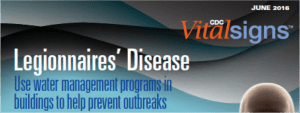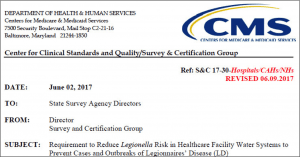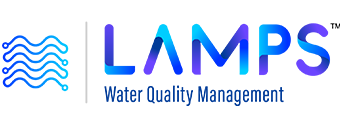Legionella Guidelines, Standards, and Regulations
The Most Important Industry and Government Legionella Documents in the United States
ASHRAE Standard 188
ASHRAE Standard 188 – Legionellosis: Risk Management for Building Water Systems – was developed by the American Society of Heating, Refrigerating and Air-Conditioning Engineers (ASHRAE) and accredited by ANSI. The June 2015 release ASHRAE 188 was a giant step for Legionella prevention in the United States in part because it represented agreement among government agencies and industry groups—not only about the need for Legionella prevention in building water systems—but also about the approach to it. To comply with ASHRAE 188, building operators must implement a water management program (WMP) for water systems that can harbor and transmit Legionella bacteria. The essential components ASHRAE 188 requires for a WMP are almost identical to those the World Health Organization outlined in 2007 (WHO 2007) and the United States Veterans Health Administration (VHA) has required since 2014 (VHA 2014). ANSI/ASHRAE Standard 188 has received widespread industry publicity and is currently recognized as the prominent Legionella risk management document in the United States.
ASHRAE Guideline 12
The purpose of Guideline 12-2020, “Managing the Risk of Legionellosis Associated with Building Water Systems,” is to “provide information and guidance for control of legionellosis associated with building water systems,” in part “for use in the implementation of ANSI/ASHRAE Standard 188.”
Centers for Disease Control and Prevention (CDC) Publications Warning About the Importance of Good Water System Management
In 2016 and 2017, the CDC issued three publications on the importance of complying with ASHRAE 188:
- A report in Morbidity and Mortality Weekly Report (Garrison 2016) about a rise in Legionnaires’ disease cases and the need for better building water management.
- The Vital Signs article “Legionnaires’ Disease: Use water management
 programs in buildings to help prevent outbreaks”(CDC 2016-Vital Signs) in which the CDC told building owners and managers to “develop and use a Legionella water management program” and state and local officials to “consider changing building and public health codes to include Legionella water management programs.”
programs in buildings to help prevent outbreaks”(CDC 2016-Vital Signs) in which the CDC told building owners and managers to “develop and use a Legionella water management program” and state and local officials to “consider changing building and public health codes to include Legionella water management programs.”
- An MMWR report (Soda 2017) about the rising concern of hospital-acquired Legionnaires’ disease
- The Vital Signs article “Legionnaires’ Disease: A problem for health care facilities” (CDC 2017-Vital Signs) in which it re-emphasized that healthcare facilities should “create and use a water management program to limit Legionella and other waterborne germs from growing and spreading
Centers for Disease Control and Prevention (CDC) Guidelines and Toolkits
“Guidelines for Environmental Infection Control in Health-Care Facilities: Recommendations of CDC and the Healthcare Infection Control Practices Advisory Committee” (CDC 2003) provides recommendations for water systems and devices are pages 125-133 (139-147 of the PDF).
“Legionella Environmental Investigation Tools”
CDC WMP Development Toolkit: “Toolkit: Developing a Water Management Program to Reduce Legionella Growth and Spread in Buildings” is “designed to help people understand which buildings and devices need a Legionella water management program to reduce the risk for Legionnaires’ disease, what makes a good program, and how to develop it.”

CDC Legionella Control Toolkit “for Controlling Legionella in Common Sources of Exposure” provides guidance for Legionella control measures and responding to Legionella test results.
Centers for Medicare & Medicaid Services (CMS) Requirement to Reduce Legionella Risk
 To avoid a citation for non-compliance, hospitals and nursing homes that receive Medicare or Medicaid reimbursements must “demonstrate measures to minimize the risk of LD” per the June 2, 2017 CMS “requirement to reduce Legionella risk in healthcare facility water systems to prevent cases and outbreaks of Legionnaires’ disease (LD).”
To avoid a citation for non-compliance, hospitals and nursing homes that receive Medicare or Medicaid reimbursements must “demonstrate measures to minimize the risk of LD” per the June 2, 2017 CMS “requirement to reduce Legionella risk in healthcare facility water systems to prevent cases and outbreaks of Legionnaires’ disease (LD).”
CMS requires the facilities to “Implement a water management program that considers the ASHRAE industry standard and the CDC toolkit” but leaves the details of the program up to each facility.
In July 2018, the CMS updated its requirement (QSO-17-30), clarifying expectations and specifically noting that environmental testing for pathogens is at the discretion of the facility.
ASSE/IAPMO/ANSI Standard 12080
The ASSE “Professional Qualifications Standard for Legionella Water Safety and Management Personnel” is a certification program intended primarily for individuals serving on a water management program team or providing Legionella-related services. Becoming a certified “Legionella Water Safety and Management Specialist” requires completing 24 hours of training and passing an exam.
CTI Guideline GDL-159(20)
“Legionellosis Guideline: Practices to Reduce the Risk of Legionellosis from Evaporative Heat Rejection Equipment Systems” was published by the Cooling Technology Institute in 2020. It is a Legionella guideline for cooling towers.
Joint Commission Standard EC.02.05.02
EC.02.05.02 requires hospitals and nursing care centers to have a water management program (WMP) that “addresses Legionella and other waterborne pathogens.” The EC.02.05.02 requirements essentially boil down to having a water management program that satisfieds ASHRAE Standard 188.
State and Local (US) Regulations
Regulations for managing building water systems to reduce the risk of Legionella have been adopted in Illinois, Michigan, New York State, New York City, and Virginia. At least 3 other states have regulations proposed or pending.
Stay Informed!
Don't miss out on important announcements about regulations, technology, outbreaks, articles, and events!
Government Legionella Documents for Countries Other than the United States
- Australia: Guidelines for Legionella Control in the Operation and Maintenance of Water Distribution Systems in Health and Aged Care Facilities
- New Brunswick: Cooling towers must be registered. Requirements for cooling tower water management plans and Legionella testing as of April 2023 are mentioned but without specifics.
- Vancouver, BC: The purpose of the City of Vancouver, British Columbia regulations is to reduce the risk of Legionella and other pathogens in certain building water systems. Operating permits are required for cooling towers, decorative water features, rainwater harvesting and other alternative water systems, potable water chemical treatment systems, and potable water physical systems (e.g., filtration, reverse osmosis, or ultraviolet light). The regulation outlines control measures and testing required for each water system type. Each permitted system must have an operator with EOCP Building Water System Operator certification.
- United Kingdom Health and Safety Commision (UK HSC) The control of Legionella bacteria in water systems. Approved Code of Practice and Guidance (L8, fourth edition)
- UK HSC Legionnaires’ disease: Technical guidance. Part 1: The control of legionella bacteria in evaporative cooling systems
- UK HSC Legionnaires’ disease: Part 2: The control of legionella bacteria in hot and cold water systems
- UK HSC Legionnaires’ disease: Technical guidance. Part 3: The control of legionella bacteria in other risk systems
If you would like for your country’s document to appear in this list, please click here and enter the document title and URL link in the comments box.
Documents for Specific Organizations, Facility Types, or Jurisdictions
- Veteran’s Health Administration (VHA) Prevention Of Healthcare-Associated Legionella Disease and Scald Injury from Potable Water Distribution Systems. Directive 1061 requires a written plan, control measures, and Legionella testing in plumbing systems for VA facilities where patients, guests, or residents stay overnight.
- Technical Guidelines for the Investigation, Control and Prevention of Travel Associated Legionnaires’ Disease
- New York City Health Cooling Tower Regulations and Maintenance Program
- New York State Legionnaires’ Disease Web Page
- New York State Department of Health “Protection Against Legionella” Regulations Effective July 6, 2016
Guidelines Pertaining to Specific Water System Types
- Cooling Towers: See “Legionellosis: Best practices for control of Legionella” at www.cti.org.
- Decorative Fountains: Guidelines for Control of Legionella in Ornamental Water Features
- Pools and Spas:
- APSP/ANSI. 2009. American National Standard for Water Quality in Public Pools and Spas. Alexandria, VA: The Association of Pool and Spa Professionals. Available at www.apsp.org.
- CDC. 2018. Model Aquatic Health Code, 3rd Edition. Atlanta: Centers for Disease Control and Prevention.
- HSE. 2017. The control of Legionella and other infectious agents in spa-pool systems. Health and Safety Executive. Sudbury, UK: HSE Books. Available for purchase at HSE.gov.
- WHO. 2006. Guidelines for Safe Recreational Water Environments. Vol. 2, Swimming pools and similar recreational-water environments. Geneva: World Health Organization. Available at WHO.int
- CDC. 2017. Disinfection of Hot Tubs Contaminated with Legionella. Atlanta: Centers for Disease Control and Prevention.
Other Notable Legionella Documents
- OSHA’s 1996 Technical Manual on Legionnaires’ disease (OSHA 1996) condensed many of the Legionella research findings to date into action steps building operators could implement to reduce risk. OSHA made it clear that managing water systems to minimize Legionella bacteria was the key to reducing the risk of Legionnaires’ disease: “The likelihood of contracting Legionnaires’ disease is related to the level of contamination in the water source. …An acceptable control strategy is to minimize the number of organisms present in a water source.”
- US EPA Legionella: Human Health Criteria Document (EPA 1999)
- US EPA Legionella: Drinking Water Health Advisory (EPA 2001). The 1999 and 2001 EPA documents provided an overview of Legionnaires’ disease and prevention strategy, agreeing with the OSHA document and other publications that building water management was needed to reduce risk: “Because there is little if any person-to-person transmission of Legionella and no vaccine is available to prevent infection, risk minimization efforts are focused on breaking the chain of transmission between environmental sources of Legionella and human hosts. …For hospitals and other health care settings, regular environmental surveys of both hot water systems and distal sites should be conducted; some health departments have issued mandates for such testing.”
- US EPA Technologies for Legionella Control in Premise Plumbing Systems: Scientific Literature Review (EPA 2016)
- World Health Organization’s Legionella and the prevention of legionellosis (WHO 2007).In this document, the World Health Organization introduced the water management program framework and essential elements that were later incorporated in VHA Directive 1061 and ASHRAE 188. It also emphasized that responsibility for Legionella risk management lies with the facility: “Fundamentally, the responsibility for managing the risk of legionellosis belongs to the facility owner or manager.”
List of Guidelines and References
ASHRAE. 1998. Legionellosis: Position Paper. Atlanta: American Society of Heating, Refrigerating and Air-Conditioning Engineers.
ASHRAE. 2000. Minimizing the Risk of Legionellosis Associated with Building Water Systems. Atlanta: American Society of Heating, Refrigerating and Air-Conditioning Engineers. Available at TechStreet.com.
ASHRAE. 2015. Legionellosis: Risk Management for Building Water Systems. Atlanta: American Society of Heating, Refrigerating and Air-Conditioning Engineers. Available at ASHRAE.org
ASHRAE. 2018. Legionellosis: Risk Management for Building Water Systems. Atlanta: American Society of Heating, Refrigerating and Air-Conditioning Engineers. Available for purchase at TechStreet.com
Australian Government. 2015. Guidelines for Legionella Control in the Operation and Maintenance of Water Distribution Systems in Health and Aged Care Facilities. enHealth, Canberra. Available at Health.gov.au
Besser RE. 2002. “Legionnaires’ disease in the Unites States: Opportunities for Prevention.” In: Marre R et al, eds. Legionella. Washington, D.C.: American Society for Microbiology, 391-397
CDC. 2003. Guidelines for Environmental Infection Control in Health-Care Facilities: Recommendations of CDC and the Healthcare Infection Control Practices Advisory Committee. Atlanta: Centers for Disease Control and Prevention. Available at CDC.gov.
CDC. 2016. Developing a Water Management Program to Reduce Legionella Growth & Spread in Buildings: A Practical Guide to Implementing Industry Standards. Atlanta: Centers for Disease Control and Prevention. Available at CDC.gov WMP toolkit
CDC. 2016. Legionnaires’ Disease: Use water management programs in buildings to help prevent outbreaks. Vital Signs, June. Atlanta: Centers for Disease Control and Prevention. Available at CDC 2016 Vital Signs.
CDC. 2017. Legionnaires’ Disease: A problem for health care facilities. Vital Signs, June. Atlanta: Centers for Disease Control and Prevention. Available at CDC 2017 Vital Signs.
CDC. 2017. Developing a Water Management Program to Reduce Legionella Growth & Spread in Buildings: A Practical Guide to Implementing Industry Standards. Atlanta: Centers for Disease Control and Prevention. Available at CDC WMP Toolkit.
CMS. 2018. QSO-17-30-Hospitals/CAHs/NHs. Department of Health & Human Services, Centers for Medicare & Medicaid Services. Available at CMS.gov Medicare Provider Enrollment and Certification.
CTI. 2008. Legionellosis Guideline: Best Practices for Control of Legionella. Houston, TX: Cooling Technology Institute.
EPA. 1999. Legionella: Human Health Criteria Document. Washington, DC: U.S. Environmental Protection Agency. EPA-822-R-99-001, November 1999.
EPA. 2001. Legionella: Drinking Water Health Advisory. Washington, DC: US Environmental Protection Agency. EPA-822-B-01-005, March. Available at EPA.gov Legionella Report.
EPA. 2016. Technologies for Legionella Control in Premise Plumbing Systems: Scientific Literature Review. EPA 810-R-16-001 September. Available at EPA.gov Legionella Document Master September 2016.
Fields B, Benson R, Besser R. 2002. Legionella and Legionnaires’ Disease: 25 Years of Investigation. Clinical Microbiology Reviews 15; 3; 506-526
Garrison L, Kunz J, Cooley L, et al. 2016. Vital Signs: Deficiencies in Environmental Control Identified in Outbreaks of Legionnaires’ Disease-North America, 2000–2014. Morbidity and Mortality Weekly Report (MMWR) 65(22);576-584. Available at CDC.gov.
HSC (Health and Safety Commission). 2013. Legionnaires’ disease: The control of Legionella bacteria in water systems. Approved Code of Practice and Guidance (L8, fourth edition). Sudbury, U.K: HSE Books. Available at HSE.gov.
HSC (Health and Safety Commission). 2013. Legionnaires’ disease: Technical guidance. Part 1: The control of legionella bacteria in evaporative cooling systems. Sudbury, U.K: HSE Books. Contains public sector information published by the Health and Safety Executive and licensed under the Open Government License. Available at HSE.gov.
HSC (Health and Safety Commission). 2013. Legionnaires’ disease: Part 2: The control of legionella bacteria in hot and cold water systems. Sudbury, U.K: HSE Books. Contains public sector information published by the Health and Safety Executive and licensed under the Open Government License. Available at HSE.gov.
HSC (Health and Safety Commission). 2013. Legionnaires’ disease: Technical guidance. Part 3: The control of legionella bacteria in other risk systems. Sudbury, U.K: HSE Books. Contains public sector information published by the Health and Safety Executive and licensed under the Open Government License. Available at HSE.gov.
OSHA. 1996. Technical Manual; Section II, Chapter 7. U.S. Department of Labor, Occupational Safety and Health Administration. Available at Available at OSHA.gov.
Soda E, Barskey A, Shah P, et al. 2017. Vital Signs: Health Care–Associated Legionnaires’ Disease Surveillance Data from 20 States and a Large Metropolitan Area — United States, 2015. Morbidity and Mortality Weekly Report. June 6. Available at CDC.gov.
VHA. 2014. Prevention Of Healthcare-Associated Legionella Disease and Scald Injury from Potable Water Distribution Systems. VHA Directive 1061. Washington, DC: Department of Veterans Affairs. Available at VA.gov.
WHO. 2007. Legionella and the prevention of legionellosis. Geneva: World Health Organization. Available at WHO.int

